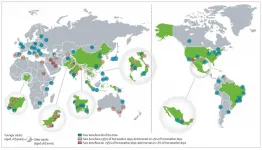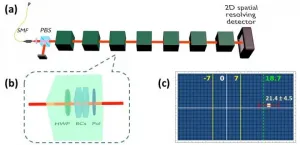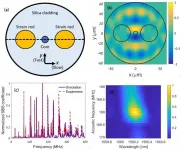(Press-News.org) Haifa, Israel June 11, 2021 - Using an ultrafast transmission electron microscope, researchers from the Technion - Israel Institute of Technology have, for the first time, recorded the propagation of combined sound and light waves in atomically thin materials.
The experiments were performed in the Robert and Ruth Magid Electron Beam Quantum Dynamics Laboratory headed by Professor Ido Kaminer, of the Andrew and Erna Viterbi Faculty of Electrical & Computer Engineering and the Solid State Institute.
Single-layer materials, alternatively known as 2D materials, are in themselves novel materials, solids consisting of a single layer of atoms. Graphene, the first 2D material discovered, was isolated for the first time in 2004, an achievement that garnered the 2010 Nobel Prize. Now, for the first time, Technion scientists show how pulses of light move inside these materials. Their findings, "Spatiotemporal Imaging of 2D Polariton Wavepacket Dynamics Using Free Electrons," were published in Science following great interest by many scientists.
Light moves through space at 300,000 km/s. Moving through water or through glass, it slows down by a fraction. But when moving through certain few-layers solids, light slows down almost a thousand-fold. This occurs because the light makes the atoms of these special materials vibrate to create sound waves (also called phonons), and these atomic sound waves create light when they vibrate. Thus, the pulse is actually a tightly bound combination of sound and light, called "phonon-polariton." Lit up, the material "sings."
The scientists shone pulses of light along the edge of a 2D material, producing in the material the hybrid sound-light waves. Not only were they able to record these waves, but they also found the pulses can spontaneously speed up and slow down. Surprisingly, the waves even split into two separate pulses, moving at different speeds.
The experiment was conducted using an ultrafast transmission electron microscope (UTEM). Contrary to optical microscopes and scanning electron microscopes, here particles pass through the sample and then are received by a detector. This process allowed the researchers to track the sound-light wave in unprecedented resolution, both in space and in time. The time resolution is 50 femtosecond - 50X10-15 seconds - the number of frames per second is similar to the number of seconds in a million years.
"The hybrid wave moves inside the material, so you cannot observe it using a regular optical microscope," Kurman explained. "Most measurements of light in 2D materials are based on microscopy techniques that use needle-like objects that scan over the surface point-by-point, but every such needle-contact disturb the movement of the wave we try to image. In contrast, our new technique can image the motion of light without disturbing it. Our results could not have been achieved using existing methods. So, in addition to our scientific findings, we present a previously unseen measurement technique that will be relevant to many more scientific discoveries."
This study was born in the height of the COVID-19 epidemic. In the months of lockdown, with the universities closed, Yaniv Kurman, a graduate student in Prof. Kaminer's lab, sat at home and made the mathematical calculations predicting how light pulses should behave in 2D materials and how they could be measured. Meanwhile, Raphael Dahan, another student in the same lab, realized how to focus infrared pulses into the group's electron microscope and made the necessary upgrades to accomplish that. Once the lockdown was over, the group was able to prove Kurman's theory, and even reveal additional phenomena that they had not expected.
While this is a fundamental science study, the scientists expect it to have multiple research and industry applications. "We can use the system to study different physical phenomena that are not otherwise accessible," said Prof. Kaminer. "We are planning experiments that will measure vortices of light, experiments in Chaos Theory, and simulations of phenomena that occur near black holes. Moreover, our findings may permit the production of atomically thin fiber optic "cables", which could be placed within electrical circuits and transmit data without overheating the system - a task that is currently facing considerable challenges due to circuit minimization."
The team's work initiates the research of light pulses inside a novel set of materials, broadens the capabilities of electron microscopes, and promotes the possibility of optical communication through atomically thin layers.
"I was thrilled by these findings," said Professor Harald Giessen, from the University of Stuttgart, who was not a part of this research. "This presents a real breakthrough in ultrafast nano-optics, and represents state of the art and the leading edge of the scientific frontier. The observation in real space and in real time is beautiful and has, to my knowledge, not been demonstrated before."
Another prominent scientist not involved with the study, John Joannopoulos from the Massachusetts Institute of Technology, added that, "The key in this accomplishment is in the clever design and development of an experimental system. This work by Ido Kaminer and his group and colleagues is a critical step forward. It is of great interest both scientifically and technologically, and is of critical importance to the field."
INFORMATION:
Prof. Kaminer is also affiliated with the Helen Diller Quantum Center and the Russell Berrie Nanotechnology Institute. The study was spearheaded by Ph.D. students Yaniv Kurman and Raphael Dahan. Other members of the research team were Dr. Kangpeng Wang, Michael Yannai, Yuval Adiv, and Ori Reinhardt. The research was based on an international collaboration with the groups of Prof. James Edgar (Kansas State University), of Prof. Mathieu Kociak (Université Paris Sud), and of Prof. Frank Koppens (ICFO, The Barcelona Institute of Science and Technology).
Researchers at the Keck School of Medicine (KSOM) of USC are among the contributors to a large-scale ethnically diverse genetic study that has expanded what we know about potential causes of type 2 diabetes.
The research, published in Nature Genetics, was conducted by the international MAGIC collaboration, made up of 400 global academics and led by researchers at the University of Exeter.
The study, a genome-wide meta-analysis, has identified more regions of the genome that are linked to blood glucose and insulin levels, features that contribute to the ...
The build-up of calcium in a major blood vessel is linked with a 39 per cent higher risk of serious falls in older women, new Edith Cowan University (ECU) research has found.
This calcium build-up, known as abdominal aortic calcification (AAC), is a hardening of the abdomen's largest artery, which can be identified early on a commonly used bone density machine scan.
The study's findings could help health professionals to identify people at risk of serious falls early to prevent future falls and their potentially life changing consequences.
Foiling future falls
Falls are a growing public health concern, causing the deaths of an estimated 680,000 people globally each year. They are also one of ...
Hokkaido University researchers have developed a simple method that converts existing generic polymers into luminescent polymers using mechanical force.
Researchers from Hokkaido University have successfully developed a new method to give luminescent properties to generic polymers, such as polystyrene and polyethylene. The technique, which was published in the journal Angewandte Chemie International Edition, makes it possible to easily prepare luminescent polymers without using complicated organic synthetic methods.
"Luminescent polymers are widely used in modern society, in applications such as organic lasers, solar cells, sensors and bioimaging, but their preparation often requires multiple chemical synthesis steps, which are both time ...
The biophysical modelling study, published in The Lancet Planetary Health, challenges outdated public health guidance that discourages fan use in temperatures higher than 35 degrees Celsius / 95 degrees Fahrenheit.
Based on human studies carried out at the University of Sydney's Thermal Ergonomics Laboratory, the researchers developed a model to determine the humidity-dependent temperature thresholds at which fans could become detrimental, providing conditions that exacerbate heat stress.
"The effectiveness of a fan depends on temperature and ...
In the field of quantum measurement, weak values, introduced in 1988 by Aharonov, Albert and Vaidman (AAV), represent undoubtedly one of the most intriguing and puzzling paradigm, with many properties in sharp contrast with respect to traditional (projective) quantum measurements.
In fact, by weakening the coupling between measured particle and measuring device, and exploiting suitable pre- and postselection, AAV demonstrated that it was possible to obtain a value of 100 while (weakly) measuring the spin of a ½-spin particle.
Such a result was obtained after averaging on multiple measurements on identically pre- and postselected ...
The gold standard in functional brain imaging for over two decades, functional magnetic resonance imaging (fMRI) has transformed the landscape of research and clinical care. Yet, because of its cost and functional limitations, scientists have continued to look for new ways to see into the human brain.
Researchers from the Keck School of Medicine of USC and the California Institute of Technology (Caltech), with the help of patients recovering from traumatic brain injury, have now demonstrated an alternative way to produce highly detailed images of the human brain. Their work, published in END ...
BURLINGTON, VT -- Findings from a study on the feasibility of addressing anxiety, pain and stress with Olfactory Virtual Reality (OVR) -- a new form of VR that incorporates the sense of smell into its augmented reality -- paint a clearer picture for clinical psychiatrists about how it could be used to safely and effectively help mental health and mood disorders. What's more, it holds promise for improved access and inclusion of patients impacted by physical limitations or constraints, such as patient mobility, comorbidities and safety.
Building on previous research proving VR's effectiveness in "distraction for pain and medical procedures, relaxation and calming, and immersion therapy for trauma, PTSD and ...
SAN FRANCISCO, CA (June 11, 2021) -- In recent years, community science--also known as citizen science--has become a global phenomenon, engaging millions of people through wildlife observation platforms like END ...
The internet era that we live in depends completely on the transfer of vast information over optical fibers. Optical fibers are literally everywhere. In fact, the overall length of optical fibers installed on our planet is sufficient to reach planet Uranus and back. However, the transfer of information from point A to point B is not enough. The information that we send and receive must also be processed. Light waves take up an increasing role in addressing that task as well. In addition, optical fibers can do more for us than just relay information: They constitute an exceptional sensing platform. Optical fibers support measurements from a long stand-off distance, simply installed within structures, ...
Researchers from University of Adelaide published a new paper in the Journal of Marketing that examines how advertising can increase the informativeness of a firm's stock price by reducing its stock price synchronicity.
The study, forthcoming in the Journal of Marketing, is titled "Tarred with the Same Brush? Advertising Share of Voice and Stock Price Synchronicity" and is authored by Chee Cheong, Arvid Hoffmann, and Ralf Zurbruegg.
Firms are sometimes "tarred with the same brush" by investors instead of being traded based on firm-specific information. ...






